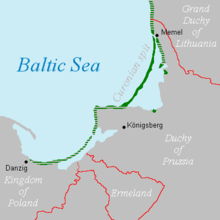lingvo.wikisort.org - Language
Kursenieki language (Kursenieki: kursisk valuod, German: Nehrungskurisch; Latvian: kursenieku valoda; Lithuanian: kuršininkų kalba) or Curonian language of the Curonian isthmus (German: kurische Sprache der Kurischen Nehrung[2]) is a dialect of the Latvian language spoken by the Kursenieki of the Curonian Spit, a thin strip of land stretching between southwestern Lithuania and the Kaliningrad exclave of Russia. In the process of various migrations of the 14th–17th centuries, Curonians (already speaking a Latvian dialect) settled along the Curonian Spit in East Prussia and became known as Kursenieki.
| Kursenieki language | |
|---|---|
| kursisk valuod | |
| Region | Curonian Spit (historically), Germany (nowadays) |
Native speakers | 2 full, 3 partial, a few passive speakers[1] |
Language family | Indo-European
|
| Language codes | |
| ISO 639-3 | – |
| Glottolog | None |
 The area of Kursenieki language speakers in 1649 | |
Influences and vocabulary
The Kursenieki language was influenced by Old Prussian, Low German, High German and the Samogitian dialect successively, and by the end of the 18th century new Curonian dialects had formed, with the dialect of the Curonian Spit being notably distinct, due to its isolation from the mainland. A Kursenieki vocabulary published in 1927 shows that 60% of Curonian words were the same as Latvian, 26% were loanwords from German, from either Low German or High German, and 13% from Lithuanian dialects. The Kursenieki language was mutually intelligible with Latvian, especially its southwestern dialects.[3]
History
Before World War II, the Kursenieki language was a sociolect of Curonian fishermen of the Curonian Spit. In other spheres of everyday life, Kursenieki used German of their surrounding environment. The events of the first half of the 20th century and the Soviet annexation of East Prussia led to the near extinction of the language, making it severely endangered. Several remaining native speakers live in Germany, having been expelled in the ethnic cleansing that took place in East Prussia after World War II.

Several pages of sample texts in Kursenieki language are included in the 1888 monograph Über die Sprache der preussischen Letten by Adalbert Bezzenberger and the 1927 monograph Kursenieku valoda by Juris Plāķis, where they describe the language spoken by the inhabitants of the Curonian Spit.[4]
There is a 2002 documentary film Tarp aštuonių vėjų ("Amidst Eight Winds") by Arvydas Barysas about the endangered Kursenieki language. The film, introducing the Curonian Spit, speaks about three brothers Sakutis (plural: Sakučiai) who had moved from the Spit to Sweden about 60 years ago, but still speak "kuršiškai".[5][6] In 2005 the film won the Best Overall Production Award at the second European Heritage Film Festival in Toblach (Italy) under the patronage of Europa Nostra.[7]
See also
References
- Kiseliunaite, Dalia (2016). "The Sociolinguistic Evaluation and Recording of the Dying Kursenieku Language". In Ferreira, Vera; Bouda, Peter (eds.). Language Documentation and Conservation in Europe (PDF). Language Documentation & Conservation Special Publication No. 9. Honolulu: University of Hawai'i Press. pp. 69–79. hdl:10125/24660.
- Skujiņa, Valentīna (2007). Valodniecības pamatterminu skaidrojošā vārdnīca. Riga: Latvian Language Agency. p. 198. ISBN 978-99-849-8369-1.
- Pietsch, Richard: Deutsch-Kurisches Wörterbuch, Verlag Nordostdeutsches Kulturwerk Lüneburg 1991, p.17, ISBN 3-922296-60-2
- Bojtár, Endre (1999). Foreword to the Past: A Cultural History of the Baltic People. Central European University Press. p. 217. ISBN 963-9116-42-4.
- "Activity Report 2004, Lithuanian National Commission for UNESCO" (PDF). UNESCO. Retrieved June 24, 2019.
- "Tarp 8 vėjų" the DVD annotation at an author's webpage (retrieved June 23, 2019)
- "EUROPA NOSTRA Pan-European Federation for Heritage - NEWSLETTER Spring 2005". Retrieved June 24, 2019.
External links
На других языках
[de] Nehrungskurisch
Nehrungskurisch (nehrungskurisch: kursisk valuod, lettisch kursenieku valoda) ist eine ostbaltische Sprache, die bis 1945 auf der Kurischen Nehrung (damals Ostpreußen) von Fischern gesprochen wurde. Es handelt sich um einen lettischen Dialekt mit starken Einflüssen der litauischen, niederdeutschen und deutschen Sprache. Es besteht kein direkter Zusammenhang zur vermutlich westbaltischen altkurischen Sprache.- [en] Kursenieki language
[ru] Курсениекское наречие
Курсение́кское наречие (наречие Куршской косы, куршникское, курсениекское) латышского языка — одно из сильно отличающихся наречий латышского языка, носители которого — курсениеки — жили до 1945 г. на севере Куршской косы.Другой контент может иметь иную лицензию. Перед использованием материалов сайта WikiSort.org внимательно изучите правила лицензирования конкретных элементов наполнения сайта.
WikiSort.org - проект по пересортировке и дополнению контента Википедии